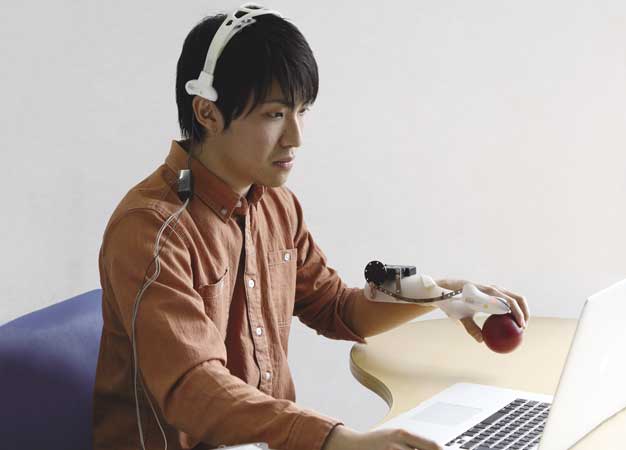Chronic stroke sufferers boost the brain's ability to heal itself through brain-machine interfaces
Published online 27 October 2016

Chronic stroke patients can regain lost movement by training their brain to control a robotic exoskeleton.
© 2016 Junichi Ushiba, Keio University
Junichi Ushiba works in the science-fictional world of brain-machine interfaces, but he doesn't like the term 'cyborg'.
"'Cyborg' sounds like 'technology's invasion of human beings'," says Ushiba, from Keio University's Laboratory for Rehabilitation Neuroscience. He's more interested in how technology can be used in a more benign way to promote the brain's self-healing abilities in people whose neurological function has been compromised by neuromuscular disease. The results have been impressive; by connecting stroke patients' brains to computers, Ushiba is helping damaged neural regions come alive.
Wiring up
An engineer by training, Ushiba became interested in the interface between engineering and neurology in 2009 when a student came to him and suggested the idea of a brain-machine interface that used noninvasive electroencephalogram (EEG) technology, involving electrodes on the surface of the skin. This approach was first developed in the 1980s to help people with 'locked-in' syndrome to communicate.
Having studied rehabilitation, Ushiba realised there was a lack of treatment options for people whose disease had affected their ability to control their arms, and who therefore couldn't manually interact with a machine or computer.
"I realized that helping the damaged brain to rewire itself using brain-machine interfaces could become an essential and unique therapy to such patients," Ushiba says. He thought that using the brain to direct actions on a computer or machine might stimulate rewiring and healing in the damaged parts of the brain that normally control those same physical movements.
So he and his research team began working with people with muscular dystrophy; a group of inherited diseases characterised by gradual muscle wastage. The aim was to see if they could control a machine with the power of their mind.
Moving thoughts
The first question was whether brainwaves recorded through the skin would be an accurate measure of activity in the parts of the brain associated with muscle control. Ushiba and his team conducted experiments in which they used EEG to look at brain and spinal cord activity in healthy volunteers who were asked to imagine moving their wrist1, 2. This showed that just imagining the movement of a limb was enough to excite the neurons in the brain and spinal cord that would normally trigger this movement.
The next step was to see what effect this approach might have in people paralysed by stroke. By this time, Ushiba's work was garnering international attention, and he began working with overseas collaborators ― including neuroscientists Surjo Soekadar from Germany and Hartwig Siebner from Denmark ― to develop the next generation of brain-machine interfaces. The international partnership has since seen one of Ushiba's master's students, Shuka Shibusawa, working in Soekadar's lab to continue the collaboration.
The team conducted an experiment in which they used real-time brain imaging to see what happened when stroke patients tried to move a paralysed finger.
After one hour of finger extension training every day for a month, Ushiba and colleagues observed increased brain activity in the damaged parts of the brain that normally would control this movement3.
The results were testament to the brain's remarkable plasticity ― its ability to 'rewire' around damage ― and showed how a brain-machine interface might facilitate this process.
Stroke therapy
But, the researchers aren't stopping there. If the neural activity associated with imagining a physical movement can be recorded, can it also be used to activate that movement?
He and his collaborators are now working to use the EEG-based brain-machine interface in humans to control a robotic exoskeleton. Animal studies by other research groups already suggest that the approach not only enables robotic-assisted movement, but the movement feeds back into the brain to further promote functional reorganisation around damaged areas.
"We believe that our brain-machine interfaces would be far more effective compared to simple robotic movement support," Ushiba says, referring to passive exoskeleton-style robotics that simply translate physical movement to robotic movement.
The team have already published numerous case studies of brain-machine interface work in people suffering chronic stroke, and found that around 70 per cent of patients show improvements in lost motor function. It offers hope to people for whom there currently are few prospects for improvement.
References
- Takemi, M., Masakado, Y., Liu, M. & Ushiba, J. Sensorimotor event-related desynchronization represents the excitability of human spinal motoneurons. Neuroscience 297, 58-67 (2015). | article
- Takemi, M., Masakado, Y., Liu, M. & Ushiba, J. Event-related desynchronization reflects downregulation of intracortical inhibition in human primary motor cortex. Journal of Neurophysiology 110, 1158-1166 (2013). | article
- Ono, T., Tomita, Y., Inose, M., Ota, T., Kimura, A., Liu, M. & Ushiba, J. Multimodal sensory feedback associated with motor attempts alters BOLD responses to paralyzed hand movement in chronic stroke patients. Brain Topography 28, 340-351 (2015). | article